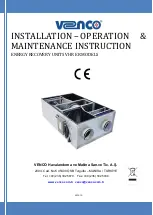
Page 30 of 72
6.4.4
Bob-weight (both types of switches)
Hang the bob weight assembly from the switch eye after cutting the chain to length if desired
to suit winch line speed. Repeat the procedure if required for rooster or fly jib. Consult
installation drawings at the rear of this manual.
6.5
Load-line (line-pull) based systems
6.5.1
Overview
Load-line (line-pull) based systems directly sense the line-pull generated to lift the load.
Sensors by using tensiometers (line-riders).
6.5.1.1
Telescopic cranes
The tensiometers are usually rigidly mounted on top of the boom base section towards the
outer end. Telescopic crane tensiometers are available in both single and twin winch versions.
The mounting base consists of a pair of 1 ½” x 1 ½” x ¼” angle irons complete with 4 off 5/8”
hi-tensile black bolts, nuts and spring washers. It is usual to weld the bolt heads to the boom
top. Consult layout drawings at the rear of this manual for more detail.
The load cell will output an electrical signal proportional to the hoist rope line-pull forces, the
RCI-1550 will then convert this into hook-load weight in tons. Correctly following the
calibration procedures is essential for accurately determining the hook load weight
6.6
Cabling and Glands
Load cell cables should be fixed firmly to the crane structure and routed to ensuring freedom
of movement around the boom pivot pin and other moving parts etc. Clip cables at 2’
intervals. Manual reeling drums are suggested cable storage devices for long lattice booms or
on cranes that require regular boom length changes.
The gland types used are designed to trap the braid or screen (or armour in certain
applications) within the braid for maximum EMI protection. Failure to terminate the screens
in the glands will void the Electro Magnetic Compatibility (EMC) compliance which the
system carries and will put the unit at risk of malfunction due to EMI. When armoured cable
is used, then the armour must be trapped in the gland body, and the internal cable braid or
screen must be terminated in the chassis terminals on the appropriate on board connectors.
The gland termination of either armour or braid is also essential for protection of the inner
conductors in the event of lightning or other transient effects. Failure to correctly terminate
within the gland may also lead to destruction of the internal circuitry in such circumstances.
File : 1550-Telescopic-HRT.DOC
Issue Date: - 01/08/05
Содержание RCI-1550 HRT
Страница 2: ......
Страница 6: ......
Страница 16: ...Page 13 of 72 File 1550 Telescopic HRT DOC Issue Date 01 08 05 ...
Страница 76: ......
Страница 78: ......
Страница 79: ......
Страница 80: ......
Страница 81: ......
Страница 82: ......
Страница 83: ...APPROVED BY TOL 0 0 0 1 2 3 4 55 26 2 0 7 2 8 9 1 1 1 1 0 7 5 6 2 ...
Страница 84: ... APPROVED BY 0 1 2 22 3 3 3 TOL 4 4 23 4 232 22 3 242 4 2 32 2 3516 7 8 7 7 9 2 3 42 4 2 ...
Страница 85: ... APPROVED BY 0 1 2 22 3 3 3 TOL 4 4 23 4 232 22 5 0 42 4 2 3617 8 9 8 8 2 ...
Страница 87: ...APPROVED BY TOL 0 0 0 1 22 3 4 5 6 0 22 2 1 7 8 98 1 7 8 98 7 8 98 7 8 98 1 0 9 8 3 6 8 3 ...
Страница 88: ......
Страница 89: ......
Страница 90: ......
Страница 91: ......
Страница 92: ......
Страница 93: ......
Страница 94: ......
Страница 95: ......
Страница 96: ......
Страница 97: ......
Страница 98: ......
Страница 99: ......
Страница 100: ......
Страница 101: ......
Страница 102: ......
Страница 103: ......
Страница 104: ......
Страница 106: ......
Страница 107: ......
Страница 108: ......
Страница 109: ......
Страница 110: ......
Страница 111: ......
Страница 112: ......
Страница 113: ......
Страница 114: ......
Страница 115: ......
Страница 116: ......
Страница 118: ......
Страница 119: ......
Страница 120: ......
Страница 121: ......
Страница 122: ......
Страница 123: ......
Страница 124: ......
Страница 125: ......
Страница 126: ......
















































